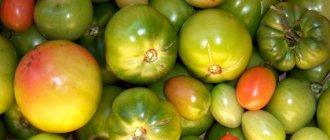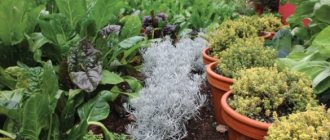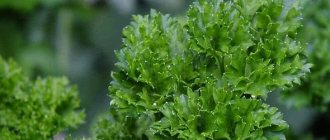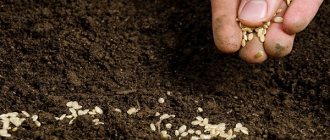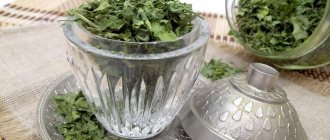What affects germination
The germination of seeds depends on their quality, as well as the type of soil in which they are placed.
Seed quality
Seeds are divided into classes I and II. In the first class the germination percentage is 60–70%, and in the second class it is 30–40%. To increase these indicators, it is necessary not to deepen the seed more than 2–2.5 cm into the soil. If you plan to mulch the beds, the seeding depth should be 1–1.5 cm.
Type of soil for growing
Parsley loves fertile soil with good mineralization. The best option would be light loams and sands; Can also be grown on drained peat bogs. Soil acidity indicators should be at 6.5–7 pH. Groundwater should not come close to the surface.
Dense soils that do not allow moisture to pass through well, and also have an acidic or alkaline reaction are absolutely unsuitable for plants.
We recommend that you learn about the peculiarities of using parsley during pregnancy.
Parsley planting technology for fast germination
Juicy parsley is grown in open ground in summer cottages, in greenhouses and on window sills.
The culture is rich in vitamins B, E, PP, and there is more ascorbic acid in this green than in lemon. And in ancient Rome they believed that parsley sprigs brought family well-being and contributed to longevity. Growing spicy, healthy herbs yourself is a simple process. However, some nuances and features of this process are useful for every gardener to know. In this article we will tell you in detail how to quickly germinate parsley seeds, when to sow seedlings and wait for germination.
Planting dates and creating the right conditions for planting different varieties
Parsley seeds can germinate at temperatures of +1...+5°C. This is what you need to start from when determining the sowing date.
Early varieties
These plant varieties, regardless of their type (leaf, root), are not planted in the soil before April. For them, the main thing is that by this time the soil in the region has already thawed and warmed up a little.
Medium varieties
Mid-season varieties can begin to be planted from the 20th of April and continue sowing until the first ten days of May. The harvest can be harvested 80–130 days after germination.
Late varieties
The same goes for late varieties. Sowing begins on the 20th of April and continues until the first ten days of May. Can be harvested after 130–180 days.
Important! After planting any variety, the bed must be covered with covering material. You need to leave it in the garden until the first shoots appear. It will retain moisture in the soil and maintain the required temperature.
Sow parsley in open ground
After treating the seeds with vodka/peroxide and germination, we begin planting the seeds in the garden. Planting technologies are as follows:
- For planting, make small grooves up to 5 cm deep. The distance between the grooves is 20-25 cm.
- Parsley seeds are placed in grooves. To prevent wet small seeds from “sticking” to your fingers, they are mixed with flour, dry sand or talcum powder. Talc and sand take away some of the moisture, so it will be more convenient to sow such seeds. The movements of your fingers when sowing are as if you are “salting” the bed with a mixture of sand and seeds.
- The grooves are covered with earth to the top and watered with water. When watering, the soil settles in the grooves, forming depressions.
The soil is covered with polyethylene to preserve moisture. After the first shoots appear, the polyethylene is removed and the ground is covered with mulch.
Proper preparation of seeds and soil for planting
Rapid germination of seeds can be obtained with proper preparation for sowing, as well as with a well-fertilized bed.
Preparation of planting material
The main preparation of the seed consists of soaking it.
There are various ways to carry out the procedure:
- Wrap the seeds in gauze and place them in warm water for 2-3 days. The fluid should be changed 1-2 times a day. Afterwards, dry the seed until it becomes free-flowing.
- A faster way to germinate a seed is with a pink solution of potassium permanganate. The seeds are soaked in it overnight. Afterwards they are wrapped in damp gauze and placed near the battery.
- The day before planting, place the seed in a glass of water with the addition of one drop of potassium humate. Cover the glass with the bottom half of a plastic bottle with holes cut in the bottom. The structure must be placed near the battery. The next day, dry the seeds and start sowing.
- In 2-3 hours you can treat the seed with Zircon. Cotton pads are moistened with the product and the seeds are laid out on them.
- In an accelerated version of removing the oily shell, both hot water and vodka can be useful. It is enough to soak the seed in one of these liquids for 10–15 minutes.
Did you know? In the 1st century AD e. The ancient Roman writer Pliny argued that salads and sauces should not be served without parsley.
Preparing the bed
The bed for the crop should be prepared in a sunny place, protected from drafts. The site should not be swampy (water does not stagnate in the spring after snow melts, after rains, groundwater does not come close to the surface). The best predecessors are tomatoes, cucumbers, and onions.
The bed needs to be prepared in the fall . Humus is added. The ideal option would be to generously feed the predecessors with organic matter, after which the crop will be planted in the spring. Then there is no need to prepare the beds in the autumn - you just need to remove all plant debris. In the spring, complex mineral fertilizers containing sufficient potassium and phosphorus are applied.
Terms, methods of harvesting and storage rules
Leaf parsley is cut throughout the growing season.
Store it frozen or dried. To make dry greens more fragrant, watering is limited several weeks before cutting. Root crops are dug up in the fall before the onset of stable frosts - at the end of October. By this time, the pulp becomes dense and juicy. The harvest is harvested on a sunny day. Before this, the tops are cut off, leaving petioles no more than 1 cm high. Then the roots are cleared of soil and dried. Early and mid-ripening varieties are dried and canned; late-ripening varieties are suitable for long-term storage.
Parsley is an indispensable spice in cooking, cosmetology and folk medicine. The unpretentiousness of the crop allows it to be grown in unfavorable climatic conditions. In regions with short summers, it is better to play it safe and always soak the seeds before sowing so that the parsley sprouts quickly. In this case, you will not be left without aromatic spicy herbs.
Source
Sowing technology
Sowing is carried out using the following technology:
- In the bed, grooves are dug with a depth of 1.5–2 cm (loamy, sandy loam soil) or 3–3.5 cm (peat bog). 20–30 cm are left between the grooves.
- Seeds are placed in the grooves at intervals of 8–10 cm.
- The plantings are sprinkled with a 1–1.5 cm layer of soil or humus. The bed is compacted and mulched.
Important! You can sprinkle the seeds with soil and use humus as mulch.
Sprouts, when planted densely, are thinned out; There should be 3–5 cm between shoots. Be sure to loosen the soil 3-4 times during the growth period. The first feeding is carried out with the appearance of 2-3 true leaves. In total, there should be 1-2 feedings and the same amount of watering during the growing season.
How long does it take for parsley to grow?
How long does it take for parsley to sprout? Slowly - on average from 10 to 14 days. This feature is due to two main factors.
Firstly, each seed is protected by a dense shell, through which it is not easy for sprouts to break through. Secondly, the surface of the shell is covered with a layer of essential oils that prevent moisture from penetrating into the grain.
If you sow parsley with dry, unprepared seeds, seedlings will appear no earlier than after 2-3 weeks.
Important. Sowing with pre-sprouted seeds guarantees the emergence of seedlings 7-10 days earlier.
The main sowing method is planting in open ground. Dry and germinated seeds are sown from early spring to early July.
Another way is winter sowing. In this case, dry material is embedded in the ground in October. In spring, such crops begin to develop when the temperature rises to +4°C.
Parsley is also grown in seedlings. The germinated seeds are sown in peat cups and the plants are transplanted into open ground within 30-40 days.
How to speed up the germination process
As mentioned earlier, parsley sprouts slowly. This process can be accelerated at the stage of preparing the seed by processing it. In addition, the use of covering material (film or spunbond) on the bed with the crop will help speed up the appearance of sprouts. It will help retain moisture in the soil, which is so necessary for the seeds to “start”. You can also speed up the germination process if you water the bed with water at a temperature of +38...+40°C. After how many days the shoots appear depends on the ambient temperature.
Video: How to sow parsley
How many days will it take for parsley to sprout?
Lime is sometimes advertised as a quick germination agent that will cause the seeds to sprout within 3 hours. It is not true. Parsley usually takes about a month to germinate. If you use dry lime, it will germinate in a few days.
Pre-soaking the seeds in vodka and peroxide also speeds up germination. Shoots may appear in 3-5 days if it is already warm, and in a week if the air is not yet warm enough.
What is the best way to plant parsley?
Many gardeners do not prepare a special bed for parsley, but plant it among other crops. In principle, you can plant parsley among any vegetables except carrots. Most often, parsley is diluted in beds with tomatoes. They are often planted around areas with potatoes, along the edges of furrows. Such planting can be carried out only after the potatoes have been hilled for the last time.
Did you know? In the 17th century, parsley was used
in medicine as a medicine with anti-inflammatory, wound-healing and diuretic effects.
Methods of using the plant were described in a popular medical book of that time called “Cool Vertograd”. As you can see, the most effective way to speed up germination is to soak the seed in various solutions. There is nothing new in this procedure. Before planting, all seeds go through it, with the only difference being that for parsley it is extremely important, since without it the seedlings will not be friendly, and they will have to wait a very long time.
What does parsley look like when it comes up?
Parsley seedlings look typical for any seedling. Sprouted parsley seeds produce thin sprouts that are milky white in color. Almost immediately they form the first pair of leaves of a light green color. Then more and more new leaves begin to actively appear, the seedlings grow stronger, the stem thickens and becomes bright green.
The foliage, initially oval, eventually takes on the classic feathery shape.

